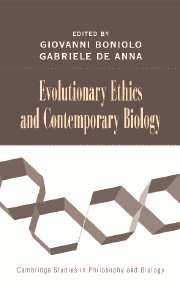Book contents
- Frontmatter
- Contents
- List of Contributors
- Evolutionary Ethics and Contemporary Biology
- Introduction
- PART I THE LIMITS OF EVOLUTIONARY EXPLANATIONS AND JUSTIFICATIONS OF ETHICS
- PART II METHODOLOGICAL ISSUES CONCERNING EVOLUTIONARY ACCOUNTS OF ETHICS
- 3 Are Human Beings Part of the Rest of Nature?
- 4 The Nature of Resemblance: Homologues in the Nervous System and Behavioral Correspondence
- PART III HOW BIOLOGICAL RESULTS CAN HELP EXPLAIN MORALLY RELEVANT HUMAN CAPACITIES
- PART IV HOW BIOLOGICAL RESULTS CAN HELP EXPLAIN MORAL SYSTEMS
- Index
- Cambridge Cultural Social Studies
- References
4 - The Nature of Resemblance: Homologues in the Nervous System and Behavioral Correspondence
Published online by Cambridge University Press: 23 July 2009
- Frontmatter
- Contents
- List of Contributors
- Evolutionary Ethics and Contemporary Biology
- Introduction
- PART I THE LIMITS OF EVOLUTIONARY EXPLANATIONS AND JUSTIFICATIONS OF ETHICS
- PART II METHODOLOGICAL ISSUES CONCERNING EVOLUTIONARY ACCOUNTS OF ETHICS
- 3 Are Human Beings Part of the Rest of Nature?
- 4 The Nature of Resemblance: Homologues in the Nervous System and Behavioral Correspondence
- PART III HOW BIOLOGICAL RESULTS CAN HELP EXPLAIN MORALLY RELEVANT HUMAN CAPACITIES
- PART IV HOW BIOLOGICAL RESULTS CAN HELP EXPLAIN MORAL SYSTEMS
- Index
- Cambridge Cultural Social Studies
- References
Summary
It would be very difficult for any one with even much more knowledge than I possess, to determine how far animals exhibit any traces of … high mental powers. This difficulty arises from the impossibility of judging what passes through the mind of an animal; and again, the fact that writers differ to a great extent in the meaning which they attribute to the above terms, causes a further difficulty.
Darwin 1871, p. 85INTRODUCTION
Morality is related variously to behavioral tendencies and cognitive capacities. In this chapter, I do not discuss what the forms and modes of these relations can be. Instead, I focus on the topic of the homologues in the nervous system and then consider whether and to what extent the capacities that are relevant for morality can be explained through biological comparisons. Nevertheless, the quest for the biological basis of behavior and cognition must rely on a sound comparative approach, satisfying Theodor Bullock's three Rs requirement (roots, rules, relevance; cf. Bullock 1983) for the study of cognition and highly integrated behavior. The satisfaction of this requirement, indeed, seems to be the only way to discern scientifically plausible biological hypotheses from merely intriguing scientifically sounding metaphors.
In what follows, I argue that any attempt to explain (human) ethics through considerations concerning animal behavior is hopeless, unless we manage to individuate strict homological correspondences among all the feasible generic analogies between human behavior and animal behavior.
This conclusion is reached through an argument that involves five theses.
- Type
- Chapter
- Information
- Evolutionary Ethics and Contemporary Biology , pp. 56 - 74Publisher: Cambridge University PressPrint publication year: 2006
References
- 1
- Cited by

